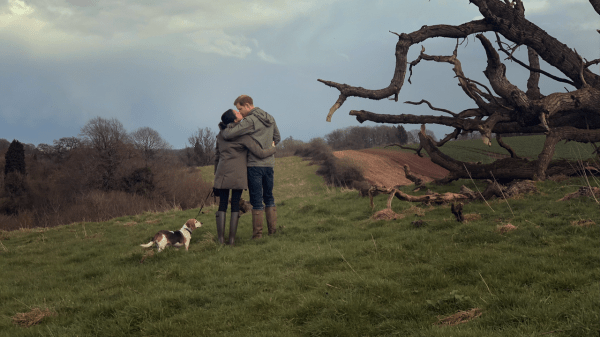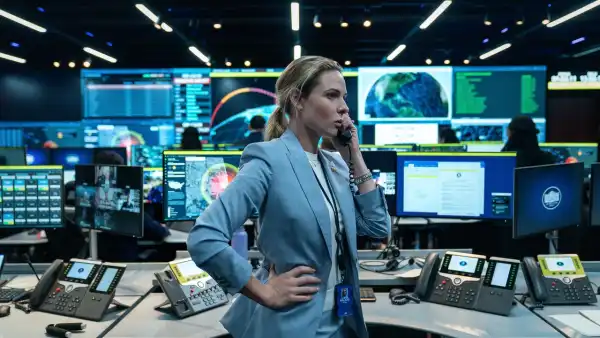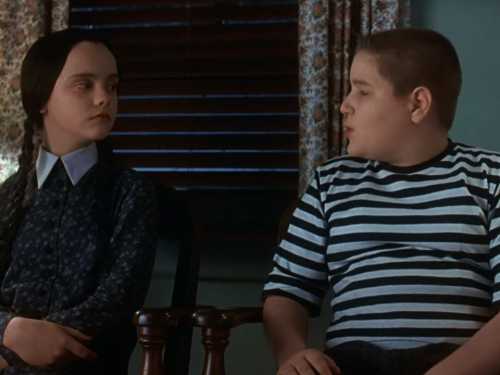
“There were three of us in this marriage, so it was a bit crowded.” Those were the pointed, devastating words that Princess Diana used, when speaking to the BBC journalist Martin Bashir in 1995, to demolish the foundations of the fairy-tale narrative that had been spun around her and the Prince of Wales. She was famously alluding to the long-standing closeness between Prince Charles and Camilla Parker Bowles, now the Queen Consort. In “Harry & Meghan,” the newly released Netflix documentary series, Harry, the Duke of Sussex, uses a similar, if less pithily expressed, formula to characterize his own sense of having been squeezed by an unwelcome triangulation: that between himself, the Palace, and the press. Harry describes a summit with other senior members of the Royal Family that was held, early in 2020, at Sandringham, one of the Queen’s country homes, to discuss what, if any, future role he and his wife, Meghan, the Duchess of Sussex, might play within the institution of the monarchy. “It was terrifying to have my brother scream and shout at me, and my father say things that simply weren’t true,” Harry said. “I think, from their perspective, they had to believe that it was more about us, and maybe the issues that we had, as opposed to their partner, the media, and themselves in that relationship that was causing so much pain for us.”
That partnership between the monarchy and the media—enduring, symbiotic, fraught, ineluctable—provides a through line for Liz Garbus, the director of “Harry & Meghan,” as well it might. Royals exist to be seen. No longer regarded as divinely authorized, and for centuries deprived—thank goodness—of meaningful legal power, the monarchy has only one real function: visibility. To be a working royal is to show up and be looked at, whether it’s attending the openings of hospital wings or factories, or arriving at galas and state ceremonies. Gifted at birth with tremendous privilege—touched by the golden tap of the good fairy’s wand—members of the Royal Family are also bound by the terms of this involuntary contract with the public and the press. The wicked fairy could hardly come up with a curse more absolute.
One of the functions of Garbus’s documentary, as it traverses the arc of the Sussexes’ engagement and marriage, their exodus from Britain, and their establishment of a new home in the paradisiacal, moneyed climes of Southern California, is to remind viewers how very good at showing up and being looked at the Duchess of Sussex was. Royals are born to public exposure, as is amply demonstrated by the footage that Garbus includes of royal newborns being displayed in their depleted royal mothers’ arms on the steps of the Lindo Wing, which houses the maternity department of St. Mary’s Hospital in London. (The Sussexes broke with tradition by having Archie delivered at a different hospital, and waited two days before bringing him out before the cameras.) As a private citizen, before her marriage, Meghan Markle actively sought visibility as an actress, a public speaker, and a blogger. When she joined the Royal Family, she brought to the role an understanding of the ways in which hers was a role, one calling for poise, grace, and—in an aspect perfected by her late mother-in-law—the outward performance of empathy.
The documentary also offers a reminder of the ways in which, as a woman of mixed race, the Duchess provided the Royal Family with helpful optics. This came into play particularly with regard to the relations between the monarchy and the Commonwealth, that voluntary, post-colonial organization of nations, many of whose citizens are brown or Black. That the Duchess is a citizen of the United States, rather than a daughter of the Commonwealth, was an anomaly or contradiction easily elided. (The documentary offers this charming anecdote: when Harry and Meghan’s second date happened to fall on July 4th, Harry showed up with cupcakes, saying that it was “a bittersweet celebration.”) Meghan’s symbolic power was transnational. On what turned out to be the Sussexes’ last international royal tour, to southern Africa, Meghan told a group of women in an impoverished South African township, “While I’m here with my husband as a member of the Royal Family . . . I am here with you as a mother, as a wife, as a woman, as a woman of color, and as your sister.” This was an exercise of soft power utterly unavailable to any other member of the institution of which she was a representative. Watching the Duchess in her brief incarnation as a servant of the crown, it is hard not to think of the ways in which the monarchy would have been that much stronger, and better equipped for the future, had it kept her in the fold.
Why did the Sussexes leave? The answer offered by the documentary is an elaboration on themes already established in other venues, most notably the interview they gave Oprah in early 2021. These include the chilliness of other members of the Royal Family (“I’m a hugger,” Meghan says. “I didn’t realize that that is really jarring for a lot of Brits”); the treachery of palace officials (Harry says that he never signed off on a peaceable joint statement issued in his and Prince William’s name in the wake of the Sandringham summit); and, above all, the relentlessness and intrusiveness of the press, and the attendant social-media onslaught. The detail with which “Harry & Meghan” lays out the couple’s case against the media—for instance, the racist commentary on Meghan’s origins in Los Angeles (her mother, Doria Ragland, was reported to live in a “gang-scarred” neighborhood), and the double standard by which Meghan’s behavior was judged compared with that of Kate, the Duchess of Cambridge—suggests that, by repeating their understandable grievances, the couple hope to be delivered of them. Mental and emotional equilibrium might still be hard to come by, despite the couple’s retelling of their story, and their embrace of therapy, yoga, and guided meditation. Harry, the final episode of the documentary reveals, blames the Mail on Sunday for the miscarriage Meghan suffered in the summer of 2020—just as he blames the tabloids for hounding his mother to her early grave. Those are losses that all the mindfulness in the world might fail to put to rest.
There are unexplored, and maybe unexplorable, threads in “Harry & Meghan,” and viewers may find themselves wishing for a more rigorous and investigative exposé of the perfidies of the rival royal-comms offices, briefing favored reporters against each other in their efforts to make their own principals shine, or a closer look at the machinery of the royal coverage in the Daily Mail. (Midafternoon on the day that Episodes 4, 5, and 6 were broadcast, the top dozen headlines on the Mail’s Web site were Harry-and-Meghan-related.) Just as Martin Bashir’s bombshell interview with Princess Diana—the access to her now known to have been gained by journalistic deception—has served as source material for Garbus, so the Netflix footage will doubtless be drawn upon by later documentarians whose producers do not include the Sussexes.
For the moment, though, this is their version of their love story. It is their fairy tale, even—complete with a wicked half sister, Samantha Markle, who is accused of disseminating anti-Meghan material on Twitter, one of an army of terrifying trolls; and a fairy godfather, Tyler Perry, who spirited the Sussex family out of Canada when the paparazzi found them there, and set them up in a Beverly Hills mansion where they enjoyed six weeks of privacy before being discovered by the Mail. Episode 6 concludes with Meghan reading aloud from her phone the speech she delivered at the couple’s wedding reception. “I wanted to share a story, a story that I wrote about the man that I love and the way that we met,” she reads. “Let’s call this a modern fairy tale. Once upon a time, there was a girl from L.A. Some people called her an actress. And there was a guy from London. Some people called him a prince. All of those people didn’t fully get it. Because this is the love story of a boy and a girl who were meant to be together.” ♦
Sourse: newyorker.com






